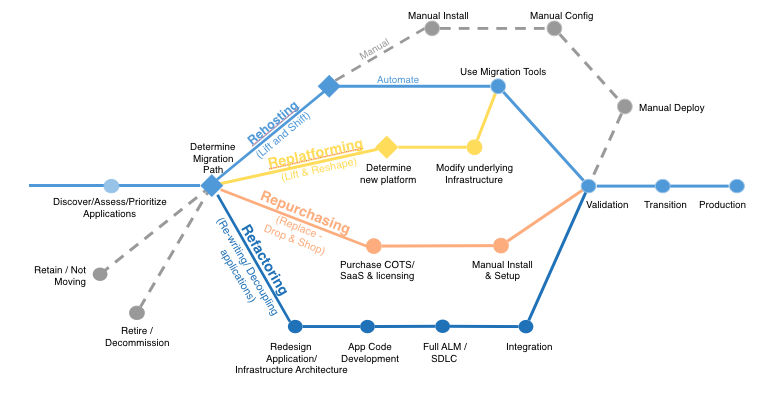Whether your business is transitioning to a completely cloud-based infrastructure, or moving just a single workload to the cloud, migrating to AWS can be seamless and speedy. But it can also turn into a surprisingly big mess. The good news is that you can determine the outcome by making the right decisions. So, that’s what we’ll cover here: the best practices and strategies that will accelerate you on the right path to a successful AWS migration. Let’s look at three best practices for your Data Center Transformation.
Build a Cloud Center of Excellence
The first best practice is about creating institutional knowledge, building consensus, and leveraging the expertise already at your disposal. You achieve all of that and more when you make it an early and sustained priority to establish a Cloud Center of Excellence, or CCoE.
The CCoE is an inter-departmental team that becomes the activity hub and information conduit for all things migratory. The size of your CCoE will likely be aligned with the size of your business, and there is no single right size. The only features your CCoE absolutely must have (a) an executive sponsor (because achieving companywide buy-in is a lot easier when you have senior-level backing) and (b) representation from as many different departments in your business as you can manage.
Why? Because a CCoE made up entirely of IT pros may seem ideal, but experience shows that it’s not a formula for success. The CCoE is the equivalent of a product delivery team, where the product is the cloud and the customer are the people in your organization affected by your migration to the cloud. The CCoE’s mission is to ensure that the customers see and receive the maximum value from your cloud migration efforts. Having representatives from the affected departments be part of the planning helps you achieve that aim.
Approach Your Cloud Migration in Phases
The second kind of best practice is process related. The idea is to think of your cloud migration as taking place in distinct phases. The exact order of the phases is flexible, and you can call the phases whatever you like. But the general categories are as follows:
- Preparation and planning. This phase focuses on business justification and business planning and takes into account considerations such as organizational change management. This is the phase where you create your CCoE.
- Technical discovery and planning. This phase is about technical preparations, such as determining the specific workloads you will migrate based on the business needs you established in the planning phase. This is where you establish size/capacity requirements for your AWS cloud presence.
- This is actually a combination of two phases, because even though they serve distinct functions, they can and sometimes do happen at essentially the same time. One is application design (determining what the migrated workload will look like and how it will function once it has been migrated) and the other is migration and validation (the actual moving of the workload to the cloud and testing to confirm that the move was successful and that the new workload has the desired functionality).
- Post-migration. This is the final phase, in which you optimize the migrated workload by making iterative improvements as you go. This is also the phase where you retire the original, pre-migrated workload.
Find the Strategies that Fit Best
Migration is a bit of an umbrella term, a fact that becomes more obvious the closer you look. Although migration always starts with a workload that isn’t (or isn’t entirely) in the cloud and leads to a version of that workload that is in the cloud, there are many ways to achieve your migration. We’ll look at the six key strategies in turn.

REHOSTING
This strategy is commonly referred to as a “lift and shift”. It is often the choice when you want to move to the cloud quickly as it involves the least amount of change to your current environment. Rehosting can be automated to simplify the level of effort using AWS tools like CloudEndure Migration and AWS VM Import/Export. Many companies also find it easier to optimize their workloads once they are already in the cloud.
REPLATFORMING
A step further than rehosting is replatforming. This strategy encompasses making a few optimizations during the migration process that you will capitalize on in the cloud. It could be removing a licensing cost with an open source alternative or using a fully managed platform like Amazon Elastic Beanstalk.
REPURCHASING
In some cases, your best bet may be to invest in a new, cloud-friendly, or cloud-native version of your workload/application, a kind of “shop and drop” strategy known as repurchasing. This will likely require that you adopt a new licensing model and is typically employed when moving to a SaaS platform. For example, moving an internal framework like your CRM or HR system to Salesforce or Zenefits respectively.
REFACTORING
This strategy is sometimes called rearchitecting and is the choice when business objectives dictate the need to scale, add features, or improve performance in a way that your current environment can’t handle. Refactoring is often done with cloud-native tools. While it can be one of the more time- and resource-intensive strategies, it can also yield significant gains in a workload’s performance, efficiency, reliability, and scalability.
RETIRING
Consider this strategy if the workload is no longer useful to business operations or you have found a better alternative to meet your business needs. In this case, the best option is to sunset the environment. Retiring will save you money, reduce your threat surface, and free up resources.
RETAINING
If after your analysis you’re still not sure about a particular workload, or you’re simply change averse, remaining status quo is often the best strategy. Doing nothing for the time being is a viable approach until your needs change or you have more information to make a decision.
Accelerate your migration to AWS
Although we have covered a lot of ground here, we have done so with a view to keeping things at a high level, and so we have just scratched the surface of these best practices. There is a lot of room to dive deeper, and we’re happy to take that plunge with you. To learn more about how we can accelerate your migration and efficiently manage your AWS environment, please feel free to get in touch; we look forward to hearing from you.




